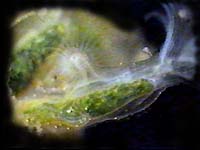
 |

 |
| Are fairies for real? Who knows... but you would certainly be forgiven
for thinking these beautiful bryozoans looked, at first glance under a
microscope, like delicate fairies of the deep.
This genus even has a name - Plumatella repens - which conjures up the 'sugar PLUM fairy' imagery of folklore and children's books. With translucent white tentacles, waving like wings in a breeze, they are a wonderful sight to greet the amateur microscopist. And Ken Jones, the renowned video specialist in the large base of UK amateurs, has captured their grace and staggering beauty for all of us to share here. |
| Bryozoans are common animals, but due to their
plant-like growth, they are often overlooked by the casual observer. Even
with moderate magnification like an 8x lens, their structure and fine mechanisms
become apparent.
These animals are known as zooids within the colonial mass, which is termed as the zooecium. Each animal is composed of two key parts; a body section containing a gut and a highly specialized U-shaped structure surrounding the mouth, called the lophophore - it is this which bears the wispy tentacles. The tentacles are ciliated - that is,
they have many fine hairs along their surface, which undulate in unison,
creating currents in the water to draw algae and protozoans (small
animals) into their mouth. The tentacles can be withdrawn and retracted
when the animal is not feeding.
|
| Left Image: colony feeding.
Right Image: ciliated tentacles.
Stunning sequences from a Ken Jones Master Video |
| These creatures thrive throughout spring and
summer, with a single animal in a colony growing up to 1 mm in diameter,
and therefore visible to the naked eye. Bryozoans survive winter only by
the production of very tiny (0.5 to 1 mm diameter) elliptical objects called
statoblasts, created asexually, which hatch-out in the following spring.
The parents, in most cases, die in the late autumn.
The tubular forms, shown here, provide an ideal place for other small creatures to conceal themselves. Sponges, insect larvae, rotifers, and protozoans are normally abundant close to the colonial mass. Colonies of bryozoans have been known to cause
blockages in main pipes both in water reservoirs and domestic outlets.
They can normally be found in most clean fresh waters, lightly adhered
to a substratum, or gathered around sticks and leaves in the water.
|

| Video Images©
Ken Jones and Micscape Magazine
Page layout & landscape sounds by Maurice Smith. All contents are copyright of Micscape Magazine Contributors 1997 Interest in commercial applications of Video sequences should be directed to: Micscape |
|
Return to Micscape Magazine Index ALL IMAGES ©KEN JONES 1996/1997 used here by permission in MICSCAPE MAGAZINE 1997 Text and page composition by Maurice Smith 1997 |
| Editor's note: Some versions of Netscape 3.0 fail to play avi movie files correctly. If the main images in this page are not constantly moving, as they should be, try clicking on them twice quickly with your mouse! This page is designed to be best viewed with a minimum of Netscape 4.0 or Explorer 4.0 Browsers. |